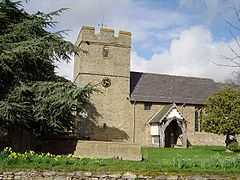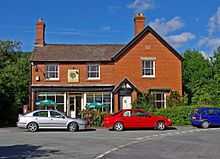Onibury
| Onibury | |
 St. Michael and All Angels parish church |
|
 Onibury |
|
| Population | 300 (2001 census)[1] |
|---|---|
| OS grid reference | SO4579 |
| Civil parish | Onibury |
| Unitary authority | Shropshire |
| Ceremonial county | Shropshire |
| Region | West Midlands |
| Country | England |
| Sovereign state | United Kingdom |
| Post town | Ludlow |
| Postcode district | SY7 |
| Dialling code | 01584 |
| Police | West Mercia |
| Fire | Shropshire |
| Ambulance | West Midlands |
| EU Parliament | West Midlands |
| UK Parliament | Ludlow |
|
|
Coordinates: 52°24′25″N 2°48′11″W / 52.407°N 2.803°W
Onibury is a village and civil parish on the River Onny in southern Shropshire, about 4 miles (6.4 km) northwest of the market town of Ludlow.
The parish includes the hamlets of Walton and Wootton and was extended in 1967 to include parts from Clungunford and Stokesay.[2] It borders the parishes of Clungunford, Stokesay (now part of Craven Arms parish), Bromfield, Culmington and Stanton Lacy. The country houses of Ferney Hall and Stokesay Court are in the parish.
History
Toponym
The toponym "Onibury" is derived from the Old English for "fortified place on the River Onny". "Onny" means "river on whose banks ash trees grew", from the Welsh "on" meaning ashes.[3]
Domesday Book
Onibury is recorded in the Domesday Book of 1086 as Aneberie. It had 15 households, making it a fairly medium-sized settlement for the time. The manor formed part of the Saxon hundred of Culvestan.[4]
Hundred
Onibury came to be in the lower division of the hundred of Munslow, following the amalgamation of Culvestan and Patton hundreds in the reign of Henry I (1100-1139).
Parish church

The Church of England parish church of Saint Michael & All Angels has a Norman chancel arch but much of the present building dates from the 14th century.[5] The nave has a queen post roof.[5] The pulpit has linenfold panelling and the nave has box pews and a west gallery.[5] St. Michael's has several 17th century monuments.[5] St. Michael's was restored under the direction of the Arts and Crafts architect Detmar Blow[5] (1867–1939). The church is a Grade II* listed building.[5]
The tower has a ring of four bells. John of Gloucester cast the second and third bells in about 1350.[6] Henry Clibury of Wellington[7] cast the tenor bell in 1676 and John Rudhall of Gloucester cast the treble bell in 1824.[6] For technical reasons the bells are currently unringable.[6]
St. Michael's is one of 17 churches in the Benefice of the Ludlow Team Ministry.[8]
John Derby Allcroft became Lord of the Manor and Patron of Saint Michael & All Angels church
Transport

Onibury had a railway station on the Shrewsbury and Hereford Railway.

The A49 road passes through the village and there is a level crossing, where there is still a signal box.
National Cycle Network route 44 passes through, via the country lanes, en route between Ludlow and Bishop's Castle.
Places near Onibury
References
- ↑ "Area selected: South Shropshire (Non-Metropolitan District)". Neighbourhood Statistics: Full Dataset View. Office for National Statistics. Retrieved 30 March 2012.
- ↑ Vision of Britain Onibury CP
- ↑ Ekwall, Eilert (1960) [1947], Concise Oxford Dictionary of English Place-Names, Oxford: Oxford University Press, p. 350, ISBN 0198691033
- ↑ Open Domesday Onibury
- ↑ 5.0 5.1 5.2 5.3 5.4 5.5 "Church of St Michael". National Heritage List for England. English Heritage. Retrieved 30 March 2012.
- ↑ 6.0 6.1 6.2 Dawson, George. "Onibury S Michael & All Angels". Dove's Guide for Church Bell Ringers. Central Council of Church Bell Ringers. Retrieved 30 March 2012.
- ↑ Dovemaster (25 June 2010). "Bell Founders". Dove's Guide for Church Bell Ringers. Central Council of Church Bell Ringers. Retrieved 30 March 2012.
- ↑ Archbishops' Council. "Benefice of the Ludlow Team Ministry". A Church Near You. Church of England. Retrieved 30 March 2012.
External links
| Wikimedia Commons has media related to Onibury. |
- Lewis, Samuel, ed. (1931) [1848]. A Topographical Dictionary of England (Seventh ed.). London: Samuel Lewis. pp. 476–479.
- The National Gazetteer of Great Britain and Ireland, 1868
- Onibury railway station
| ||||||||||||||||||||||